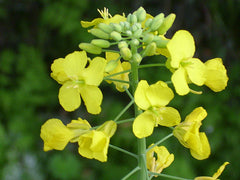Medicago Sativa, Alfalfa
Alfalfa is a very deep rooting plant, bringing up nutrients from deep in the soil and making them available for other plants with shallower root systems. It is a good companion plant for growing near fruit trees and grape vines so long as it is in a reasonably sunny position, but it does not grow well with onions or other members of the Allium genus.
A good bee plant and a food plant for many caterpillars.
Growing alfalfa encourages the growth of dandelions. Alfalfa has long been cultivated for its edible seed, which can be sprouted and eaten in salads. It is also grown as a green manure and soil restorer.
Plants are very deep rooting, descending 6 metres or more into the soil, and are able to fix large quantities of atmospheric nitrogen, this makes them one of the very best green manures.
Alfalfa is a potenially excellent source of biomass. It is possible to produce more than 2 tonnes of protein from the leaves (suitable for human use) per hectare per year.
The plant can be grown as a low dividing hedge in the vegetable garden.
A yellow dye is obtained from the seed.
The fibre of the plant has been used in making paper.
Alfalfa leaves, either fresh or dried, have traditionally been used as a nutritive tonic to stimulate the appetite and promote weight gain.
Alfalfa is a very versatile plant that can adapt to a wide range of climatic conditions from cold temperate to warm sub-tropical.. It succeeds on a wide variety of soils, but thrives best on a rich, friable, well-drained loamy soil with loose topsoil supplied with lime. It does not tolerate waterlogging and fails to grow on acid soils. Grows well on light soils. The plant has a deep taproot and, once establishd, tolerates drought and extremely dry conditions. Prefers a neutral fertile soil but succeeds in relatively poor soils so long as the appropriate Rhizobium bacteria is present.
Pre-soak the seed for 12 hours in warm water and then sow in spring in situ. The seed can also be sown in situ in autumn.
The plant contains saponin-like substances. Eating large quantities of the leaves may cause the breakdown of red blood cells. However, although they are potentially harmful, saponins are poorly absorbed by the human body and so most pass through without harm. Saponins are quite bitter and can be found in many common foods such as some beans. Thorough cooking, and perhaps changing the cooking water once, will normally remove most of them from the food. Saponins are much more toxic to some creatures, such as fish, and hunting tribes have traditionally put large quantities of them in streams, lakes etc in order to stupefy or kill the fish. Alfalfa sprouts (and especially the seeds) contain canavanine.
Edible uses








